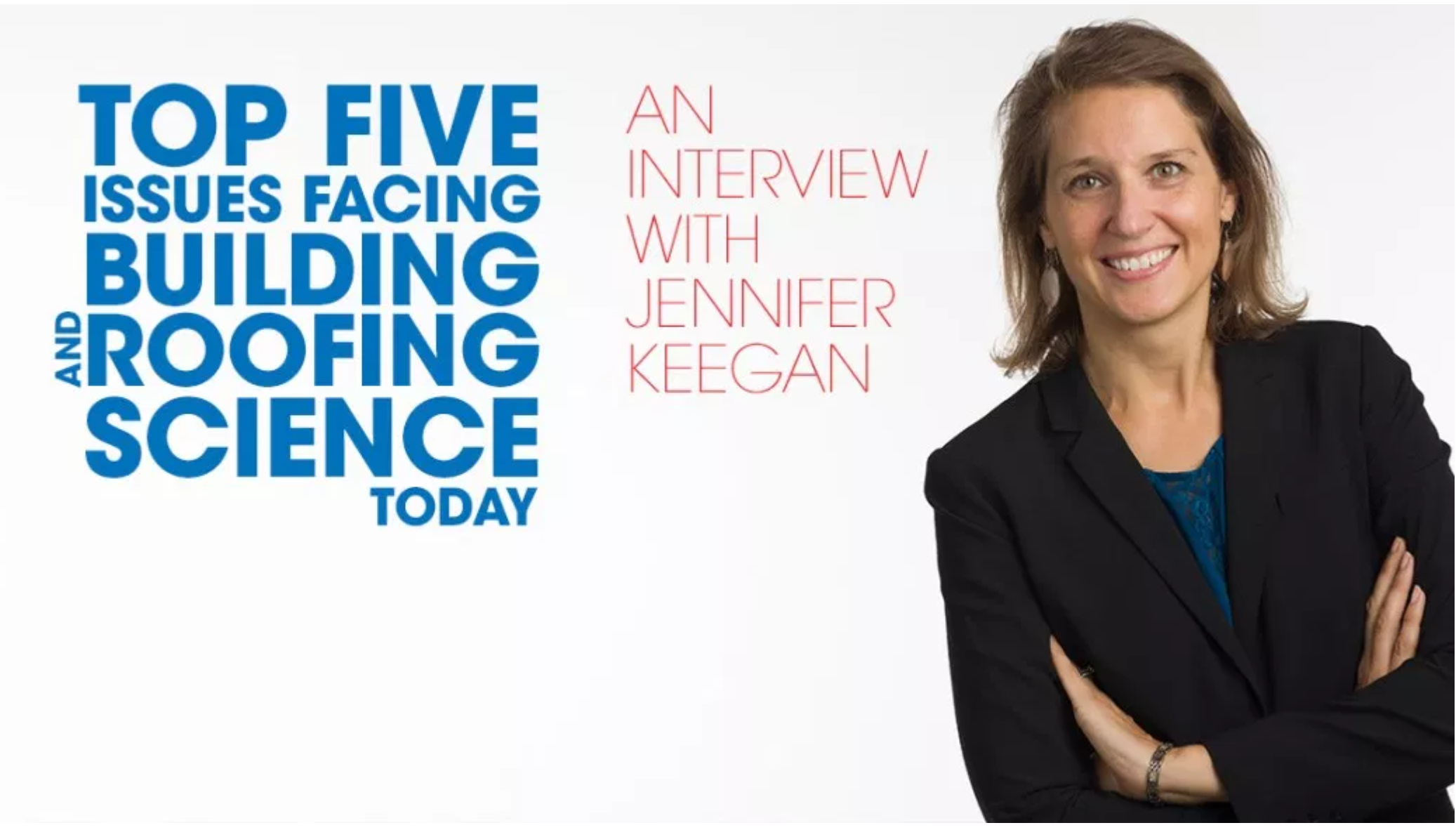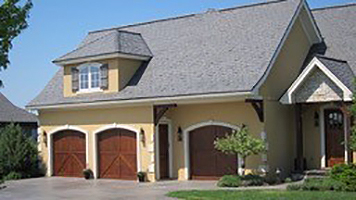Top Five Issues Facing Building and Roofing Science Today

By Don Kilcoyne.
The following is a transcript of a recent interview for the GAF ProBlog.
You can listen directly, or download the interview here.
Please note, the following conversation is intended as a general discussion of certain trends and issues in the roofing industry. It does not address GAF product offerings and makes no claims or representations about any GAF products, warranties or guarantees. For information about GAF’s products, warranties or guarantees, please visit gaf.com.
DON: Today I’m chatting with Jennifer Keegan, who recently joined GAF as the Director for Building and Roofing Science. Hi, Jennifer!
JENNIFER: Hi Don, thanks for the opportunity to chat with you today, and our listeners.
DON: Jennifer, since you’re new to GAF, it’s likely you’re also new to many of our Blog readers. Would you mind sharing a bit of your background?
JENNIFER: Not at all! I graduated with degrees in architecture and civil engineering and knew I didn’t want to be in traditional design in either field. Fortunately, I found building enclosure forensics and started my career learning how systems fail and how to repair them.
Naturally this led me into construction defect litigation. I found that I enjoyed a more collaborative approach and had the opportunity to develop a building science team. This opened the door to engage with new construction projects and allowed me to collaborate with architects to make their designs function and perform as intended.
DON: Jennifer, you and I have spoken about the many disruptors shaking up commercial roofing today. The industry is significantly more dynamic than many people may think. So as the new director of Building and Roofing Science here at GAF I‘m curious about what YOU think the top four or five issues facing our industry will be in the coming year?
JENNIFER: As you said, there’s a lot going on, but here are some of the issues we’ll be focusing on here in GAF Building Science. In no particular order, transfer of knowledge, code changes and adoption, warranties, value engineering, and of course, the ongoing labor shortage.
Issue 1: Transfer of knowledge
DON: Oh yeah. Great. Let’s break those down, then if you don’t mind. When you say transfer of knowledge, between whom, and about what?
JENNIFER: Transfer of knowledge should be dynamic and flow in all directions. We all experience roofing in different ways and have different stories to share.
The reality of active job sites — we’re looking at weather, steep slope, access challenges, adjacent construction, dust, and debris — these all challenge the research conducted in a conditioned lab and theoretical modeling calculated in our offices.
Increasing the communication from theoretical lab research to architect, consultants, contractors, and owners is paramount, and vice versa. Soliciting information from these parties and sharing our experiences in a way that positively influences future systems options, design and installation, is how we continue to innovate through high-performance buildings.
DON: And it sounds like it’s a bit of a balancing act between the two…
JENNIFER: Absolutely. Building on this is the confusion around vapor retarders and air barriers in regards to roofing. What are we trying to accomplish by adding these elements to the design? Control of vapor diffusion to address the moisture drive associated with the curing of concrete decks? Or over metal decks? Or energy efficiency and condensation control resulting from air movement?
Complicating these matters are the code changes in the 2018 IECC, which now requires air barriers in all new buildings. So, understanding how that applies to your new roof, the new addition, or the reroof is important, yet somewhat confusing.
Issue 2: Code changes and adoption
DON: It sounds like that goes hand-in-hand with what you mentioned as your second topic, code changes and adoption. Is the terrain changing any way to make compliance and adoption more challenging recently?
JENNIFER: Well, there’s always going to be… learning the changes in any new code is going to be challenging. There is a learning curve that we had from the 2012 and 2015 IBC to the 2018 IBC. The IBC adoption at state and local jurisdictions vary; so what rules apply where?
I was talking with one contractor who shared with me that depending on which side of town his project is on, he can have to comply with 4 different versions of code. So, this transfer of knowledge is critical — and that’s between architects, consultants, contractors, and owners alike.
So let’s talk about the winds of change – obviously talking about ASCE-7-16. The ASCE 7-16 revises all of the category maps. Calculating the wind speed using version 16 compared to version 10 can increase the perimeter zones 3-fold. It increases the complexity in determining the roof zones; and significantly increases the design pressures in hurricane prone regions.
There’s this larger disconnect in what is required by code, as compared to FM Global’s criteria — which applies only to buildings insured by FM manufacturers, but is not necessarily clear in all specifications — and then what is covered in roof manufacturer warranties. Keep in mind that code provides minimum requirements and contrast that to FM Global’s criteria, which can result in a significant wind load due to the required importance factors and safety factors that FM applies.
So calculation of these wind design loads can also vary pretty greatly. There are some great tools out there, but depending on which one you use, you can get very different results. This again ties us back to that transfer of knowledge. All of this leads to confusion at the local level — what is required and who is responsible?
So the lingering question with wind uplift is what it means relative to warranties, which is not a code requirement.
Issue 3: Warranties
DON: Well, you had mentioned warranties as a particular concern, but what I don’t understand is how does the education role, or the communication role, of Building Science, affect warranties?
JENNIFER: We manufacture parts of roofs in plants, and the contractor essentially manufactures the roof system in the field. So partnering is critical to offer this meaningful warranty.
The focus on warranties tends to be on duration. But is it a material or labor warranty or a systems warranty? Does it cover workmanship? Overburden? Is it an NDL [No Dollar Limit]? What are the terms as it relates to ponding water? Hail? And wind uplift?
So if we’re talking about an addition or a roof recover, existing moisture and sound substrate become critical parts to this equation. But who’s responsible for evaluating these conditions and how do they impact your warranty? Are they going to require roof cores?
Also understanding what can void your warranty. Roof maintenance is a required part of many warranties. Timely reporting of leaks is also a common requirement, and often allows the manufacturer or the contractor to conduct their own investigation into the cause of the reported leak.
Utilizing a contractor certified by the manufacturer may also be required for warranty coverage – for the installation, the maintenance, and repair.
All of this keeps going back to the transfer of knowledge, which is paramount.
Issue 4: Value engineering
DON: And I suspect we’ll keep coming back to knowledge transfer, because your fourth concern was value engineering and that sounds like a knowledge sharing opportunity. So what’s the change that you would like to see?
JENNIFER: Value engineering has become a norm in our industry. Every project is understandably cost and schedule driven, which always brings the project team to that value engineering discussion.
Value engineering used to be a very performance-based event. However, today’s discussions and decisions are frequently based on cost and schedule, and performance is taking a back seat in these discussions.
The change I’d like to see is bringing these conversations back to performance and having informed discussions around performance concessions instead of focusing only on cost and schedule. As the saying goes, Don, you get what you pay for!
DON: That’s true!
Jennifer: Value engineering often modifies the overall roof system design by changing, removing, or reducing components, and modifying construction details in order to reduce installation time and material costs. These changes can come at a significant loss. Service life is often compromised, and the roof system performance can be significantly reduced.
For an example, a roof can be designed, maybe, as a fully adhered system with a vapor retarder and PMMA flashings. The GC might offer to save the owner time and money by using a mechanically attached system, eliminating the vapor barrier, skinnying up the cover board and using conventional flashings. This is a dramatic change in the performance of the roof system, which isn’t always clearly communicated or understood by all the parties in these value engineering sessions. If they don’t invest in the performance upfront, the owner may be paying for it in the long run, which will consume more time and money than they initially saved. So, a life cycle versus initial cost analysis might be helpful in refocusing these conversations on performance.
And again, it all keeps coming back to knowledge and communication for informed decisions.
Issue 5: Labor shortage
DON: And your final area of focus is one that the whole industry is facing — residential, commercial, reroof, and new construction. And that’s the labor shortage. The workforce is aging. Skilled labor is in very short supply. But how does that impact the efforts of Building Science? Or, if I can flip that, how does Building Science stand to make a positive impact on the labor shortage?
JENNIFER: Don, the labor shortage is not limited to roofing contractors. I would argue that this is spread across our industry from R&D, through plant manufacturing, to consulting, field inspectors and everyone in between.
There’s a huge need for talent in our industry. So everybody in the industry has the opportunity to make a positive impact. The Building Science Team is very engaged with our industry organizations and participate in those, such as the NRCA — which is the National Roofing Contractors Association — RCI, which is a roofing consultant focused organization, and NWIR — National Women in Roofing.
Our primary focus is the transfer of knowledge, from the building science side. And one avenue is through engagement in these organizations. Yet there’s something more powerful going on. As these organizations are joining together, they are collaboratively focusing on solutions which include Advocacy, Recruitment, and Labor Saving Design.
Joint Advocacy has led to a deliberate and strategic way to engage policy makers on what matters most in the roofing industry
Earlier this year they hosted the first Roofing Day in Washington, DC. All of these organizations came together — NRCA, RCI, NWIR — and met on the stairs of the Capitol and spoke of legislation on immigration reform and training that’s needed to support our workforce.
DON: Is that the first of, hopefully, an annual thing?
JENNIFER: Absolutely. There are also efforts with recruitment through diversity.
NRCA has a committee on diversity. They’re reviewing our demographic changes to help develop a long-term plan — addressing our aging population, engaging millennials, involving women and the minority workforce — because today’s workers are tomorrow’s leaders.
So through that effort, the NRCA is developing certification programs — to create industry standards, and lay out a career path, which will help improve the perception of our industry.
So, National Women in Roofing focuses on 4 pillars: recruitment, networking, education and mentoring. All of which support recruitment and retainment of women in the roofing industry. And there’s a lot of opportunity here, because women make up 1% of the roofing industry.
DON: Really!
JENNIFER: Really. So when we look at the opportunities here, we have this great opportunity to recruit and through this also elevate the perception of our industry.
There is also an organization called RT3, which is Roofing Technology Think Tank: And they are engaging millennials through technology. They’re reaching outside of our industry and looking at all of this available technology and seeing how we can utilize that in our roofing industry. All of these initiatives are necessary to enhance recruitment and the image of our industry. So, as they say, be the change you wish to see.
Labor saving design and products to reduce the complexity of roof installation is certainly an effort ongoing throughout the industry.
Through technology, with estimating software and tools, drones, IoT (Internet of Things)… all of these efforts are trying to enhance the roofing industry.
Simplification of the installation process to reduce the schedule and the skills required for installation, and then prefabrication options as well.
DON: So it’s not just bringing more people into the industry, but actually reducing the burden on the existing labor force, by being faster, smarter, and more effective.
JENNIFER: Exactly, Don. So, Building Science is a systems approach to buildings. Understanding the physical behavior of the building as a system and how this impacts durability, energy efficiency, and tenant comfort is essential in the advancement of high-performance buildings. So this is the core of the technical training we as the Building Science team hope to bring to architects, explaining why buildings work, why they fail, and how to avoid the latter without compromising their design.
Building science was born out of innovation….and the resulting failures encountered when these principles were not fully understood at the time. So as we continue our journey on the advancement of high performance buildings, the role of building science continues to reinforce this dynamic relationship between theory and practice in our industry and the importance of knowledge transfer.
DON: Thank you to everyone who downloaded (or read) this interview, and I’d also like to thank Jennifer Keegan, Director of Building and Roofing Science here at GAF. This has been really fascinating for me and I look forward to following up with you in the coming year and tracing how some of these issues are being met by the good people here at GAF.
JENNIFER: Thanks, Don.
Jennifer Keegan is the Director of Building & Roofing Science for GAF. This position is focused on the relationships between individual roofing materials and the overall roof system and building envelope performance. Jennifer has over 20 years of experience as a building enclosure consultant specializing in assessment, design, and remediation of building enclosure systems. Her experience ranges from design assist efforts, to forensic investigations, litigation support, and repair design. Jennifer provides technical leadership within the industry as the Chair of the ASTM D08.22 Roofing and Waterproofing Subcommittee and as an advocate for women within the industry as the educational chair for National Women in Roofing and a board member of Women in Construction.
Editor’s note: This first published on GAF’s blog and can be viewed here.






















Comments
Leave a Reply
Have an account? Login to leave a comment!
Sign In